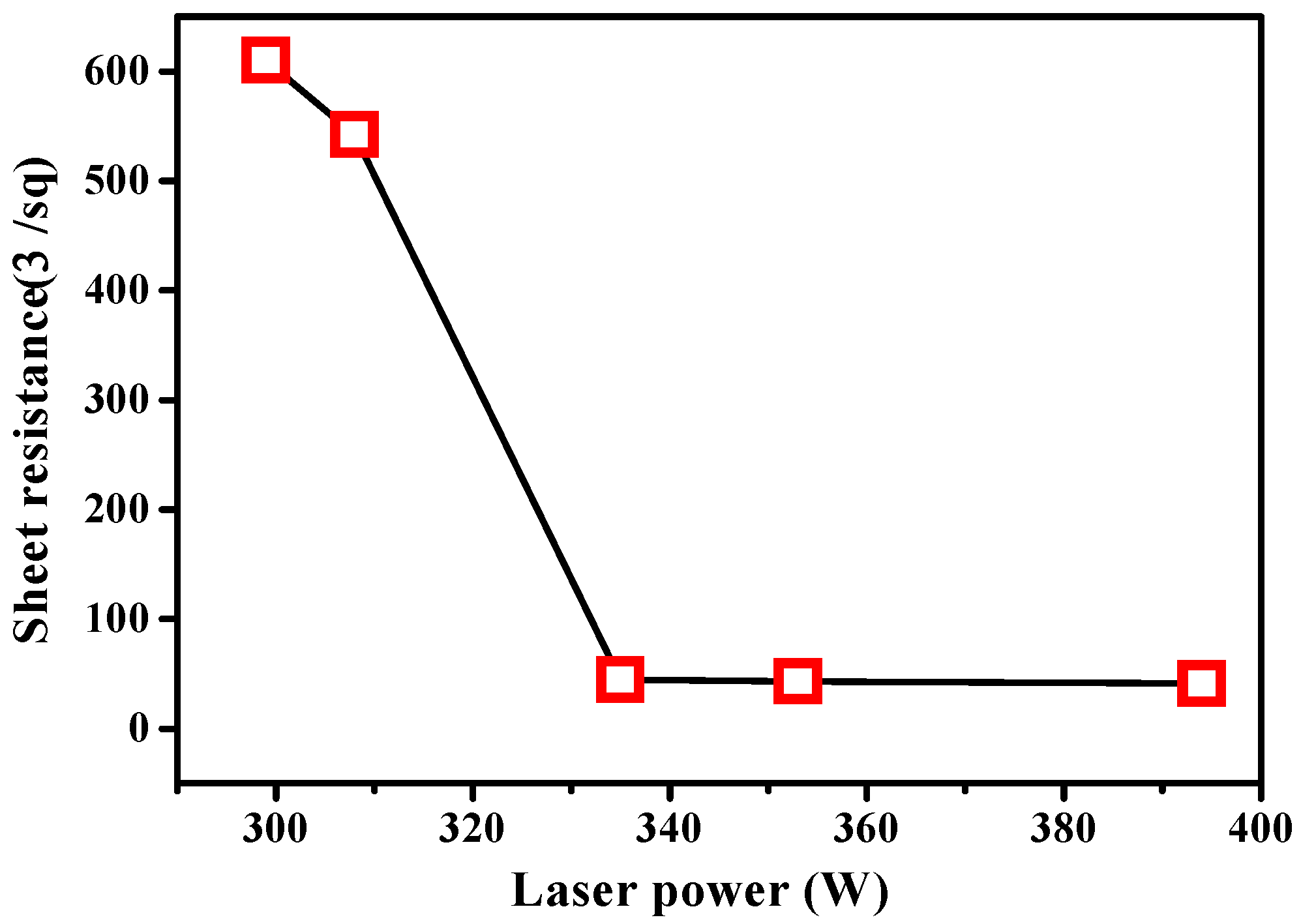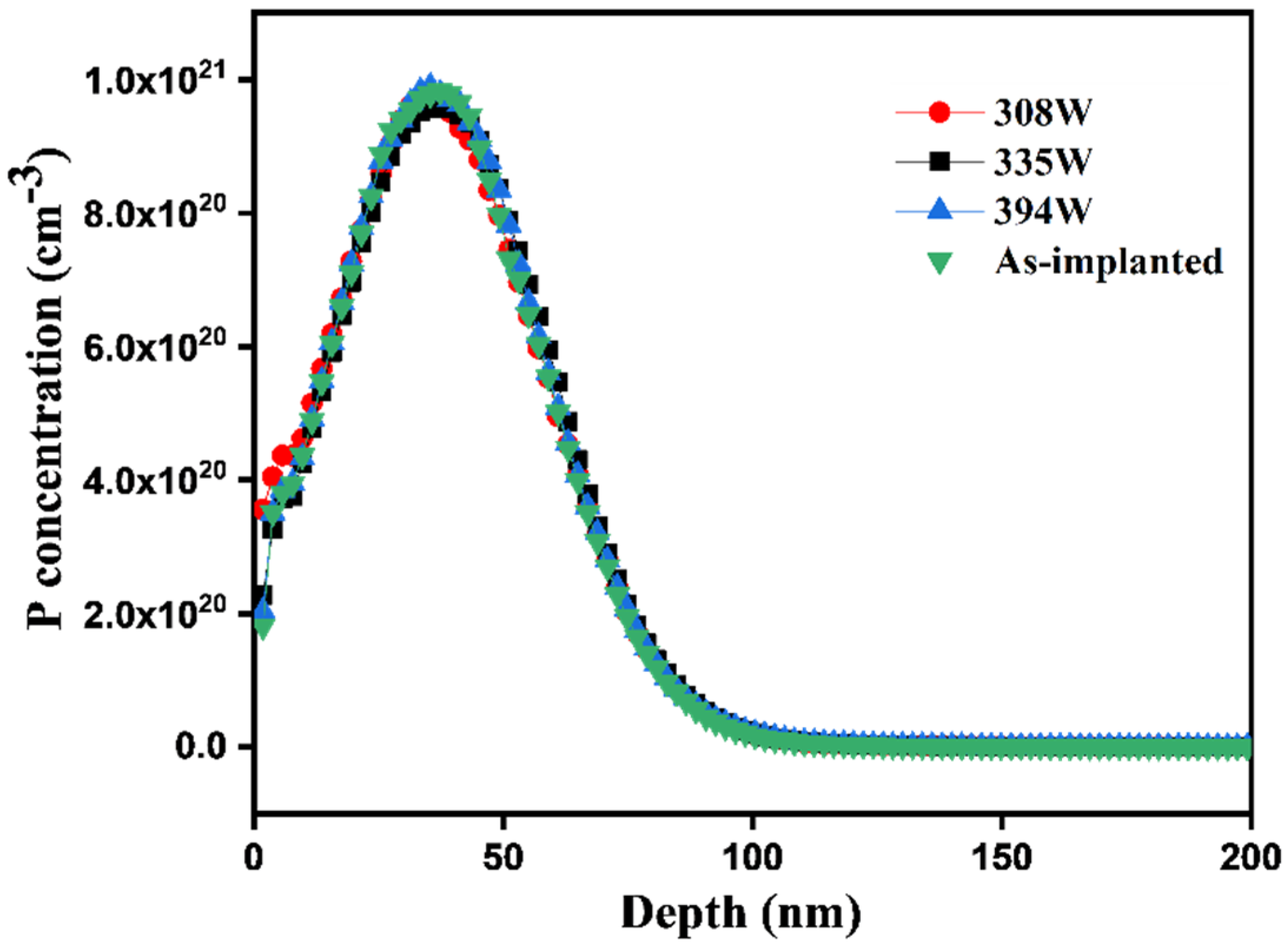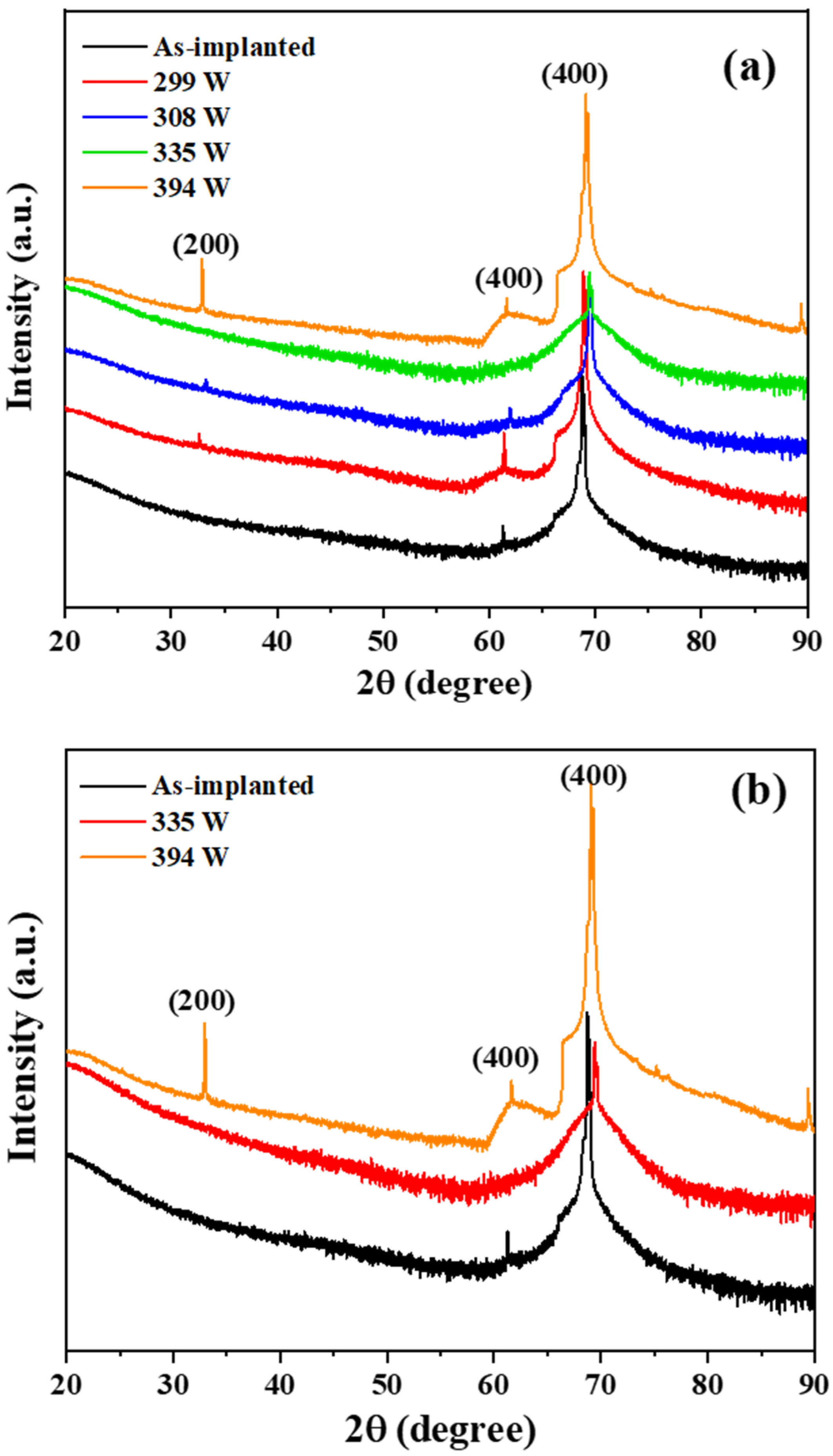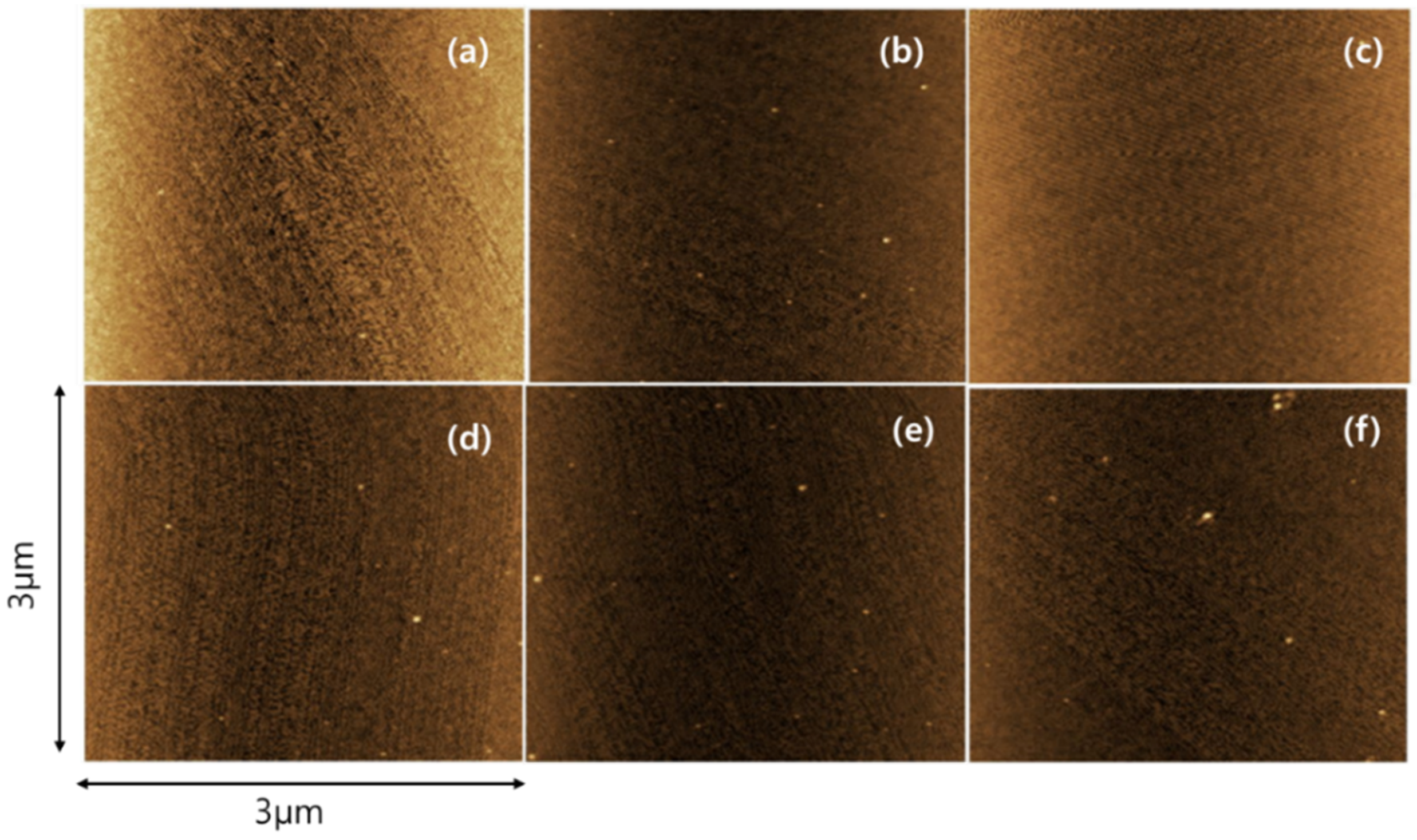Comprehensive Analysis of Phosphorus-Doped Silicon Annealed by Continuous-Wave Laser Beam at High Scan Speed
Abstract
1. Introduction
2. Methods
2.1. Sample Preparation and Laser Annealing Experiment
2.2. Sample Analysis Methods
3. Results and Discussion
3.1. Analysis of Sheet Resistance
3.2. Analysis of the Structural Evolution under Different Laser Powers
3.3. P Concentration Profile Analysis by SIMS
3.4. Atomic Structure Analysis by XRD
3.5. Surface Morphology and Roughness Analysis by AFM
4. Conclusions
- A CW laser source with a high scan speed (10 m/s) achieved through a laser beam scanner system was employed in this study. It exhibited unique characteristics in reducing the sheet resistance, which improved the electrical properties of the fabricated material.
- The TEM results showed a complete crystallization with Epi regrowth of an a-Si layer with a thickness of approximately 80 nm. There was no formation of a polycrystalline structure at higher temperatures during laser processing owing to the effect of the high scan speed used in this study.
- The P profile analysis by SIMS showed the P concentration of the fabricated material that attained complete crystallization without diffusion into the Sub-Si although the process was carried out at a temperature higher than the melting point of Si. This was enabled by the high scan speed.
- There was only a small variation in the lattice spacing reflected in the (400) XRD peak, which indicated that laser annealing had a negligible effect on the strain in the annealed region.
- The AFM analysis results of the annealed samples were almost identical to those of the as-implanted sample.
Author Contributions
Funding
Data Availability Statement
Conflicts of Interest
References
- Luong, G.; Wirths, S.; Stefanov, S.; Holländer, B.; Schubert, J.; Conde, J.; Stoica, T.; Breuer, U.; Chiussi, S.; Goryll, M.; et al. Study of dopant activation in biaxially compressively strained SiGe layers using excimer laser annealing. J. Appl. Phys. 2013, 113, 204902. [Google Scholar] [CrossRef]
- Rosseel, E.; Profijt, H.B.; Hikavyy, A.Y.; Tolle, J.; Kubicek, S.; Mannaert, G.; L’abbe, C.; Wostyn, K.; Horiguchi, N.; Clarysse, T.; et al. Characterization of epitaxial Si: C: P and Si: P layers for source/drain formation in advanced bulk FinFETs. ECS Trans. 2014, 64, 977. [Google Scholar] [CrossRef]
- Weeks, K.D.; Thomas, S.G.; Dholabhai, P.; Adams, J. Characterization and analysis of epitaxial silicon phosphorus alloys for use in n-channel transistors. Thin Solid Films 2012, 520, 3158–3162. [Google Scholar] [CrossRef]
- Lee, M.; Ko, E.; Ko, D.-H. Probing lattice vibration and strain states in highly phosphorus-doped epitaxial Si films. J. Mater. Chem. C 2017, 5, 9744–9752. [Google Scholar] [CrossRef]
- Shin, H.; Lee, M.; Ko, E.; Ryu, H.Y.; Park, S.; Kim, E.; Ko, D.H. Dopant activation of in situ phosphorus-doped silicon using multi-pulse nanosecond laser annealing. Phys. Status Solidi A 2020, 217, 1900988. [Google Scholar] [CrossRef]
- Yang, G.; Ingenito, A.; Isabella, O.; Zeman, M. IBC c-Si solar cells based on ion-implanted poly-silicon passivating contacts. Sol. Energy Mater. Sol. Cells 2016, 158, 84–90. [Google Scholar] [CrossRef]
- Li, B.-j.; Yang, G.-y.; Huang, L.-j.; Zu, W.; Li, H.; Wang, Y.-l.; Li, S.-s.; Ren, N.-f. Surface morphology and photoelectric properties of FTO ceramic thin films under a simple transparent cover-assisted laser annealing. Mater. Res. Bull. 2018, 108, 151–155. [Google Scholar] [CrossRef]
- Li, B.-j.; Li, H.; Huang, L.-j.; Zu, W.; Ren, N.-f.; Ding, H.; Kong, X.; Zhang, J.-l. Performance optimization of fluorine-doped tin oxide thin films by introducing ultrasonic vibration during laser annealing. Ceram. Int. 2017, 43, 7329–7337. [Google Scholar] [CrossRef]
- Luo, J.; Xia, J.; Yang, H.; Malik, H.A.; Han, F.; Shu, H.; Jia, C. Novel approach toward hole-transporting layer doped by hydrophobic Lewis acid through infiltrated diffusion doping for perovskite solar cells. J. Nano Energy. 2020, 70, 104509. [Google Scholar] [CrossRef]
- Gupta, M.C.; Zhigilei, L.V.; He, M.; Sun, Z.J. Generation and annealing of crystalline disorder in laser processing of silicon. In Handbook of Laser Micro- and Nano-Engineering; Sugioka, K., Ed.; Springer: Cham, Switzerland, 2020; pp. 1–31. [Google Scholar] [CrossRef]
- He, M.; Wu, C.; Shugaev, M.V.; Samolyuk, G.D.; Zhigilei, L.V. Computational study of short-pulse laser-induced generation of crystal defects in Ni-based single-phase binary solid-solution alloys. J. Phys. Chem. C 2019, 123, 2202–2215. [Google Scholar] [CrossRef]
- Michalak, T.J.; Herman, J.; Basavalingappa, A.; Rodgers, M.; Franca, D.; Borst, C. Study of millisecond laser annealing on recrystallization, activation, and mobility of laser annealed SOI doped via arsenic ion implantation. J. Vac. Sci. Technol. B 2015, 33, 011201. [Google Scholar] [CrossRef]
- Chang, R.-D.; Lin, C.-H. Activation and deactivation of phosphorus in silicon-on-insulator substrates. Mater. Sci. Semicond. Process. 2016, 42, 219–222. [Google Scholar] [CrossRef]
- Chery, N.; Zhang, M.; Monflier, R.; Mallet, N.; Seine, G.; Paillard, V.; Poumirol, J.; Larrieu, G.; Royet, A.; Kerdilès, S.; et al. Study of recrystallization and activation processes in thin and highly doped silicon-on-insulator layers by nanosecond laser thermal annealing. J. Appl. Phys. 2022, 131, 065301. [Google Scholar] [CrossRef]
- Sun, Z.; Gupta, M.C. A study of laser-induced surface defects in silicon and impact on electrical properties. J. Appl. Phys. 2018, 124, 223103. [Google Scholar] [CrossRef]
- Walter, D.; Fell, A.; Franklin, E.; Wang, D.; Fong, K.; Kho, T.; Weber, K.; Blakers, A.W. Damage-free ultraviolet nanosecond laser ablation for high efficiency back contact solar cell fabrication. Sol. Energy Mater. Sol. Cells 2015, 136, 1–10. [Google Scholar] [CrossRef]
- Rebohle, L. The Technology of Flash Lamp Annealing. In Flash Lamp Annealing; Springer: Berlin/Heidelberg, Germany, 2019; pp. 15–70. [Google Scholar] [CrossRef]
- Lu, J.-P.; Yonggen, H.; Yong, C. Millisecond anneal for ultra-shallow junction applications. In Proceedings of the IEEE International Workshop on Junction Technology Extended Abstracts, Shanghai, China, 10–11 May 2010; pp. 1–4. [Google Scholar]
- Prucnal, S.; Rebohle, L.; Reichel, D. Semiconductor Applications. In Flash Lamp Annealing; Springer: Berlin/Heidelberg, Germany, 2019; pp. 131–232. [Google Scholar] [CrossRef]
- Cacho, F.; Bono, H.; Beneyton, R.; Dumont, B.; Colin, A.; Morin, P. Simulation of pattern effect induced by millisecond annealing used in advanced metal-oxide-semiconductor technologies. J. Appl. Phys. 2010, 108, 014902. [Google Scholar] [CrossRef]
- Ni, C.-N.; Li, X.; Sharma, S.; Rao, K.; Jin, M.; Lazik, C.; Banthia, V.; Colombeau, B.; Variam, N.; Mayur, A. Ultra-low contact resistivity with highly doped Si: P contact for nMOSFET. In Proceedings of the IEEE Symposium on VLSI Technology, Kyoto, Japan, 16–18 June 2015; pp. T118–T119. [Google Scholar] [CrossRef]
- Ni, C.-N.; Rao, K.; Khaja, F.; Sharma, S.; Tang, S.; Chen, J.; Hollar, K.; Breil, N.; Li, X.; Jin, M. Ultra-low NMOS contact resistivity using a novel plasma-based DSS implant and laser anneal for post 7 nm nodes. In Proceedings of the IEEE Symposium on VLSI Technology, Honolulu, HI, USA, 14–16 June 2016; pp. 1–2. [Google Scholar] [CrossRef]
- Gluschenkov, O.; Liu, Z.; Niimi, H.; Mochizuki, S.; Fronheiser, J.; Miao, X.; Li, J.; Demarest, J.; Zhang, C.; Niu, C. FinFET performance with Si: P and Ge: Group-III-Metal metastable contact trench alloys. In Proceedings of the IEEE International Electron Devices Meeting, San Francisco, CA, USA, 3–7 December 2016; pp. 17.2.1–17.2.4. [Google Scholar] [CrossRef]
- Kiyama, H.; Kato, S.; Aoyama, T.; Onizawa, T.; Ikeda, K.; Kondo, H.; Hashimoto, K.; Murakawa, H.; Kuroiwa, T. Advanced Flash Lamp Annealing Technology for 22nm and Further Device. In Proceedings of the IEEE International Workshop on Junction Technology Extended Abstracts, Shanghai, China, 10–11 May 2010; pp. 1–6. [Google Scholar] [CrossRef]
- Shugaev, M.V.; He, M.; Lizunov, S.A.; Levy, Y.; Derrien, T.J.Y.; Zhukov, V.P.; Zhigilei, L.V. Insights into laser-materials interaction through modeling on atomic and macroscopic scales. In Advances in the Application of Lasers in Materials Science; Springer Series in Materials Science; Springer: Cham, Switzerland, 2018; Volume 274, pp. 107–148. [Google Scholar] [CrossRef]
- Choi, D.; Shin, J. Study of phosphorus-doped Si annealed by a multi-wavelength laser. Results Phys. 2022, 38, 105632. [Google Scholar] [CrossRef]
- Current, M.I.; Lee, Y.J.; Lu, Y.L.; Cho, T.C.; Chao, T.S.; Onoda, H.; Tokoro, N. Microwave and RTA annealing of phos-doped, strained Si (100) and (110) implanted with molecular Carbon ions. In Proceedings of the IEEE International Workshop on Junction Technology (IWJT), Kyoto, Japan, 6–7 June 2013; pp. 84–87. [Google Scholar] [CrossRef]








| Experiment No. | Laser Power (W) | Scan Speed (m/s) |
|---|---|---|
| 1 | 299 | 10 |
| 2 | 308 | 10 |
| 3 | 335 | 10 |
| 4 | 353 | 10 |
| 5 | 394 | 10 |
| Sample | Peak Position (°, 2θ) | Lattice Spacing (Å) | Difference in Lattice Spacing (Å) |
|---|---|---|---|
| as-implanted | 69.08 | 1.3586 | 0 |
| 299 | 68.85 | 1.3626 | −0.004 |
| 308 | 69.42 | 1.3528 | 0.006 |
| 335 | 69.58 | 1.3501 | 0.009 |
| 394 | 69.07 | 1.3588 | −0.0002 |
Publisher’s Note: MDPI stays neutral with regard to jurisdictional claims in published maps and institutional affiliations. |
© 2022 by the authors. Licensee MDPI, Basel, Switzerland. This article is an open access article distributed under the terms and conditions of the Creative Commons Attribution (CC BY) license (https://creativecommons.org/licenses/by/4.0/).
Share and Cite
Taiwo, R.A.; Shin, J.-H.; Son, Y.-I. Comprehensive Analysis of Phosphorus-Doped Silicon Annealed by Continuous-Wave Laser Beam at High Scan Speed. Materials 2022, 15, 7886. https://doi.org/10.3390/ma15227886
Taiwo RA, Shin J-H, Son Y-I. Comprehensive Analysis of Phosphorus-Doped Silicon Annealed by Continuous-Wave Laser Beam at High Scan Speed. Materials. 2022; 15(22):7886. https://doi.org/10.3390/ma15227886
Chicago/Turabian StyleTaiwo, Rasheed Ayinde, Joong-Han Shin, and Yeong-Il Son. 2022. "Comprehensive Analysis of Phosphorus-Doped Silicon Annealed by Continuous-Wave Laser Beam at High Scan Speed" Materials 15, no. 22: 7886. https://doi.org/10.3390/ma15227886
APA StyleTaiwo, R. A., Shin, J.-H., & Son, Y.-I. (2022). Comprehensive Analysis of Phosphorus-Doped Silicon Annealed by Continuous-Wave Laser Beam at High Scan Speed. Materials, 15(22), 7886. https://doi.org/10.3390/ma15227886







